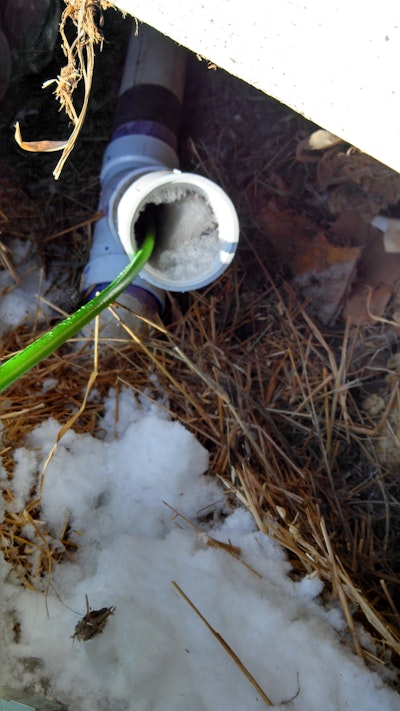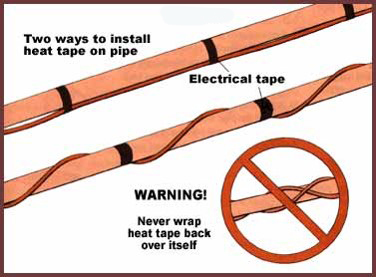Interested in Repair?
Get Repair articles, news and videos right in your inbox! Sign up now.
Repair + Get AlertsWith the extreme cold weather over the last few weeks, freezing waterlines have been reported across the U.S. Water pipes that freeze most frequently are:
- Pipes that are exposed to severe cold, like outdoor hose bibs, swimming pool supply lines and water sprinkler lines.
- Water supply pipes in unheated interior areas like basements and crawl spaces, attics, garages or kitchen cabinets.
- Pipes that run against exterior walls that have little or no insulation.
How to prevent frozen water pipes
The key issue here is exposing water pipes to warmer air. This can be done with simple techniques such as keep garage doors closed if there are water supply lines in the garage and opening kitchen and bathroom cabinet doors to allow warmer air to circulate around the plumbing. Also be sure to keep the thermostat set to the same temperature at night as during the day, and if you will be going away during cold weather, leave the heat on in the home, set to a temperature no lower than 55 degrees F.
How to protect water pipes
Before the onset of cold weather, protect your pipes from freezing by following these recommendations:
- Drain water from swimming pool and water sprinkler supply lines, following manufacturer or installer's directions.
- Remove, drain and store hoses used outdoors. Close inside valves supplying outdoor hose bibs. Open the outside hose bibs to allow water to drain. Keep the outside valve open so that any water remaining in the pipe can expand without causing the pipe to break.
- Make sure vents are closed to your crawl space and the crawl space door itself is closed
- Add insulation to attics, basements and crawl spaces to maintain higher temperatures in these areas.
- Check around the home for other areas where water supply lines are located in unheated areas. Look in the garage and under kitchen and bathroom cabinets. Both hot and cold water pipes in these areas should be insulated.
- Consider installing specific products made to insulate water pipes like a "pipe sleeve" or installing UL-listed "heat tape," "heat cable," or similar materials on exposed water pipes. Newspaper can provide some degree of insulation and protection to exposed pipes — even 1/4 inch of newspaper can provide significant protection in areas that usually do not have frequent or prolonged temperatures below freezing.
- Consider relocating exposed pipes to provide increased protection from freezing.
How to thaw frozen pipes
If you turn on a faucet and only a trickle comes out, suspect a frozen pipe. The most common locations for frozen water pipes include against exterior walls or where the water service enters the home through the foundation. Apply heat to the section of pipe using an electric heating pad wrapped around the pipe, an electric hair dryer, a portable space heater (kept away from flammable materials), or by wrapping pipes with towels soaked in hot water. Do not use a blowtorch, kerosene or propane heater, charcoal stove or other open flame device. Apply heat until full water pressure is restored. If you are unable to locate the frozen area, if the frozen area is not accessible, or if you cannot thaw the pipe, call a licensed plumber. Check all other faucets in the home to find out if there are additional frozen pipes. If one pipe freezes, others may freeze, too. The best advice is to hire a licensed professional to diagnose and repair the problem so the issue is resolved long-term. They may need to steam lines to get them thawed and can determine why the pipe frozen and make repairs and suggestions to prevent it from occurring the next time it gets cold.
What not to do
- Do NOT put antifreeze in these lines unless directed. Antifreeze is environmentally harmful and is dangerous to humans, pets, wildlife and landscaping. In addition, salt or septic system additives should be avoided.
- Do NOT start a fire over the frozen lines to attempt to thaw it out. This can cause pipes to melt.
- Do NOT run water continually to try to thaw the lines. This water will be very cold and may cause your wastewater plumbing to freeze. In addition, allowing faucets to drip can add hundreds or thousands of gallons of water to a septic system that is was not designed to handle. This overload could cause performance issues including surfacing of effluent, resulting in a frozen soil treatment area.
About the author
Sara Heger, Ph.D., is an engineer, researcher and instructor in the Onsite Sewage Treatment Program in the Water Resources Center at the University of Minnesota. She presents at many local and national training events regarding the design, installation, and management of septic systems and related research. Heger is education chair of the Minnesota Onsite Wastewater Association and the National Onsite Wastewater Recycling Association, and she serves on the NSF International Committee on Wastewater Treatment Systems. Ask Heger questions about septic system maintenance and operation by sending an email to kim.peterson@colepublishing.com.









